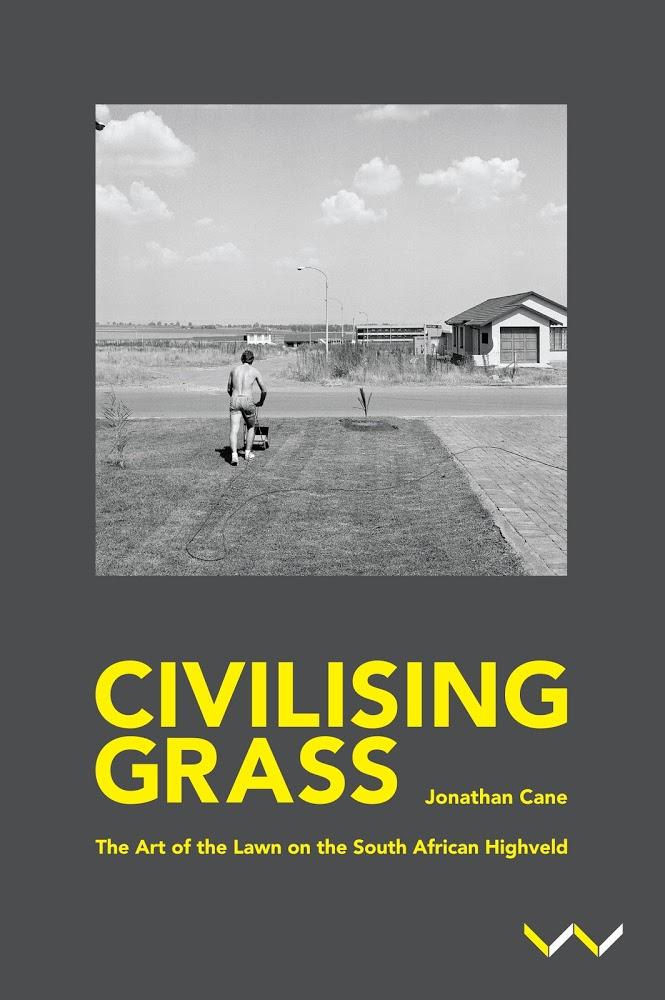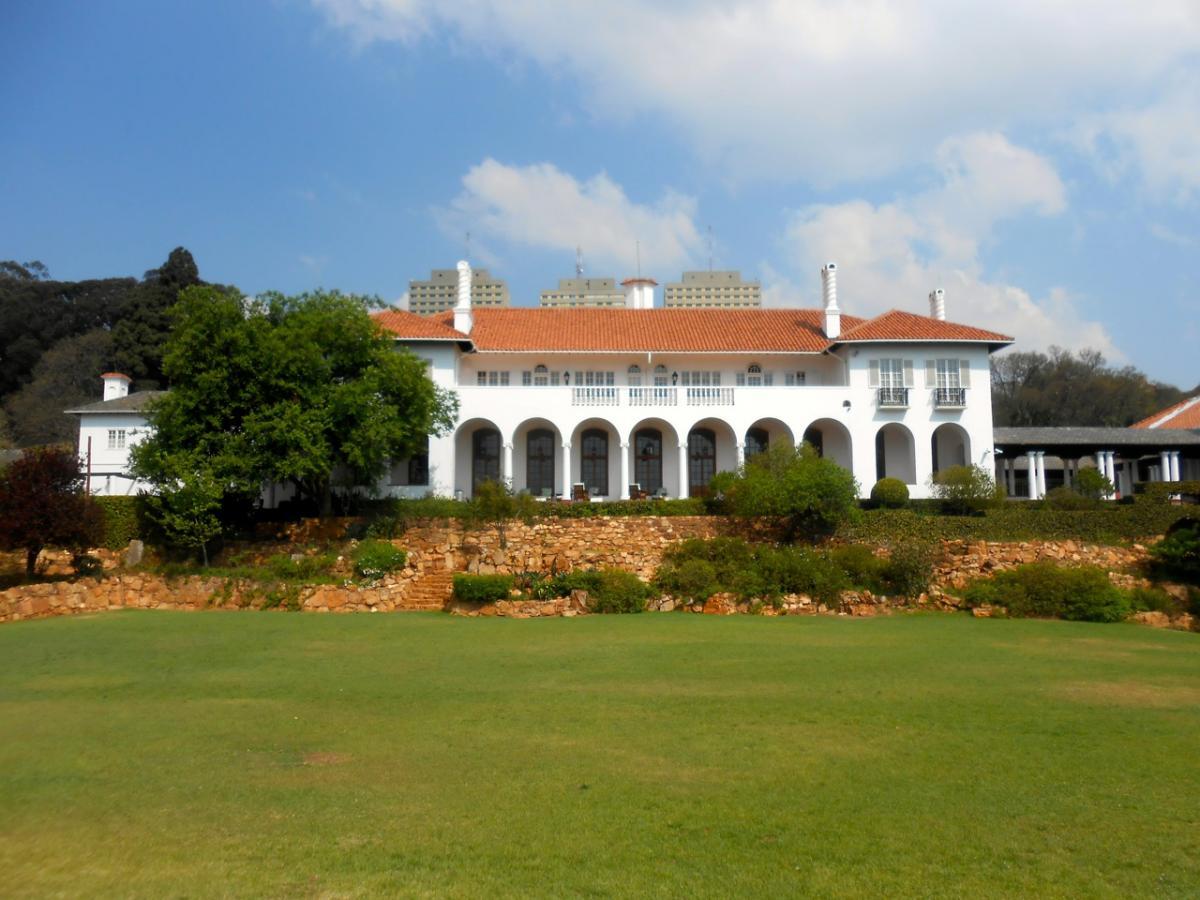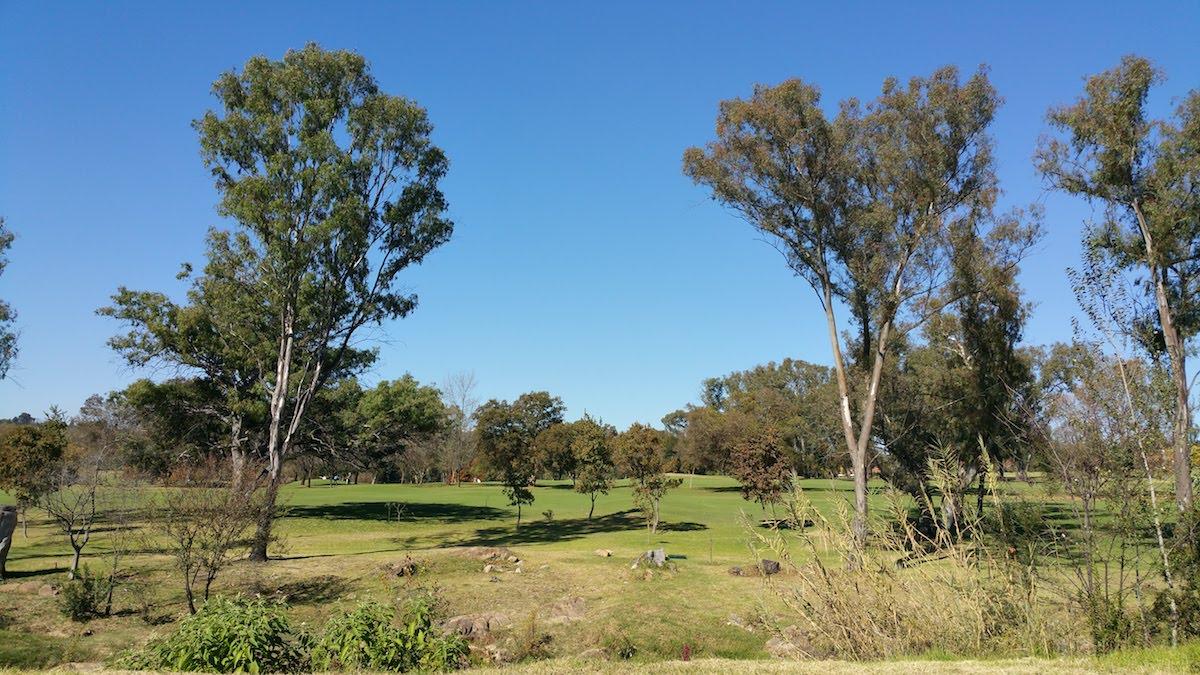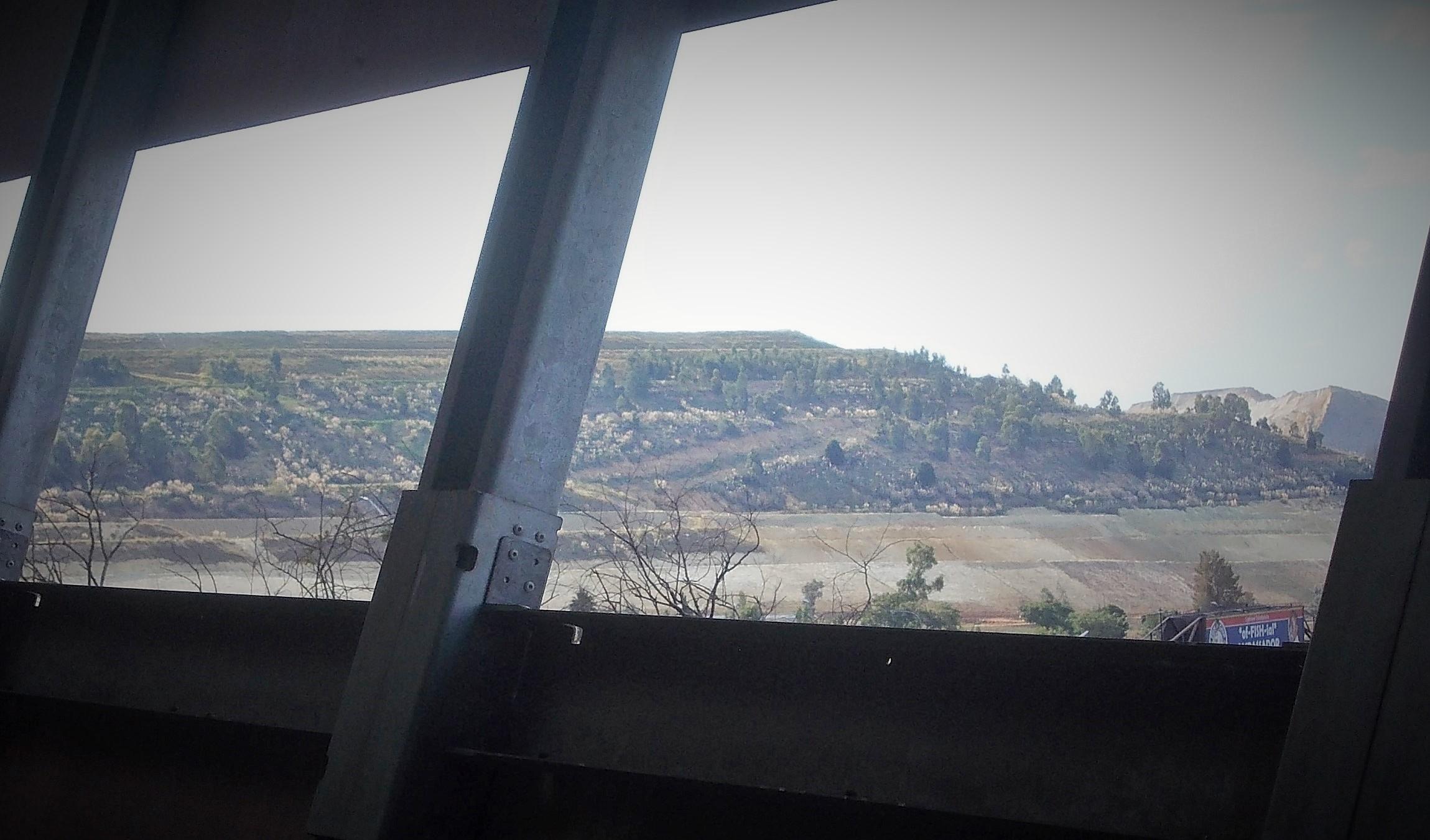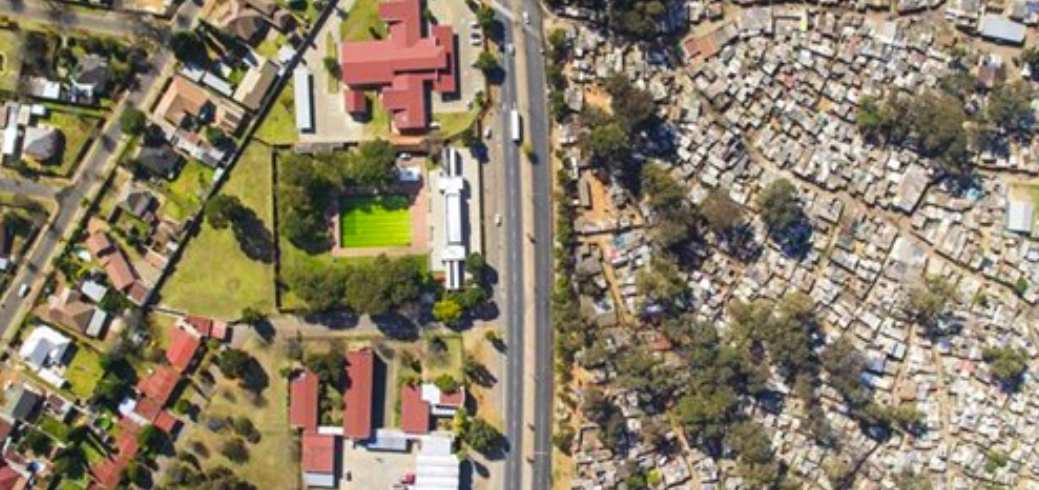
The title, Civilising Grass - The Art of the Lawn on the South African Highveld, intrigued and immediately raised questions. What is the difference between grass, veld and lawn? Why is there an art in its cultivation? What does a lawn mean? Why do some people spend precious leisure time mowing a lawn? Why do lawns matter and what do they represent? If you read this book you will find some of the answers. This is certainly a book to set you thinking. We all benefit from the author’s scholarship (the bibliography is vast). His interest lies particularly in the art and literature of the lawn. He is strong on contemporary political ideology and the makeup of the urban landscape and what part a lawn may have played in taming Africa.
The lawn in the view of the author, Jonathan Cane, was and still is a colonial idea and imported from somewhere else. Is is an essentially English idea that has no place in Africa. The lawn is something difficult to maintain, it is hard work to mow a lawn, the lawn is a family thing and a feature of the heterosexual world view but ultimately the lawn fails. Now I know - we are cultivating the wrong vegetation in the wrong spot. Johannesburg and the Highveld are ecologically not right for lawns.The central thesis is that suburbs have lawns but townships do not. Why and how did this come about? Colonial conquest of the ridges of the Witwatersrand hold the clue but it is more complex.
Book Cover
If you are someone who lives in a suburban Johannesburg house and are privileged enough to possess a private garden you are likely to have a lawn. You will be interested in the title. I bought this book at the time of publication because it looked like a promising addition to my collection of Johannesburg books and perhaps it had a lesson or two about the art of the lawn. The coloured photographs alone are worthy of close study – there are 26 plates.
Owning a house with a lawn in Johannesburg induces a love-hate relationship. The first lesson from this book is that a lawn is a luxury and the epicenter of a garden – a soft green visually appealing surface into which you sink your bare toes. You possess an exquisite green velvet carpet for play, picnics, the sundowner on the lawn alongside the turquoise pool. But cultivating a lawn requires effort, energy, and time. To grow a lawn requires planting grass seed, watering the seed or buying squares of kikuyu sods when out doing drive by shopping. This lawn may well not be a privilege but may be a duty and a responsibility. Beyond the ultimate status symbol of the suburbs of Johannesburg there is a burden of responsibility.
Villa Arcadia lawns (The Heritage Portal)
This book appealed because it spoke to the personal experience of living on the Highveld from childhood to adulthood. I know exactly what is involved in the art of the lawn; it is another suburban accoutrement to worry about. In winter the lawn on our Witwatersrand ridge needs water to stop that fade from verdant green to dying toughened ragged brown and reverting back to veld. In summer the lawn sprouts aggressively, weeds and grass grow in fierce competition, encouraged by the summer rains. The Lawn needs trimming, mowing and edges neatened. You need the tools to do the job and not only is a lawnmowner required but an edge trimmer and someone to assist with what is fast becoming hard work. The someone has to be a willing husband (boyfriends will never mow a lawn) or you employ a gardener and in no time you are on the slippery slopes of master servant relationships amidst the greenery of Africa.
I must share a secret. I am a failed gardener and lawn keeper. A few years ago I tried to spread grass seed on a rocky stretch of open land that pretends to belong to my garden and the resultant grass only looks good at a distance. Close examination still shows up insistent weeds and those hard little ‘klippies”. Sometimes bigger rocks creep to the surface - these items of geology that must have been there when Bezuidenhout was the farm owner and there were no suburb. Now I know precisely why I have failed and why I can blame the whole lawn enterprise on my ancestors and on history. Having read this book I can give up lawn cultivation, I can carry on reading soothed by this book, feet up and a relaxing tipple at hand in a deck chair on what was the lawn but now happily reverts back to veld and bush. All guilt about a failed lawn disappears.
Nonetheless, we find lawns all over the world. My most interesting encounters with lawn in other cultures came with visits to Moscow, Germany and to England. In Moscow I encountered a city beauty spot - with a park where people spread themselves in summer, grass grew soft wild and tall but there was no lawn. I asked the innocent question... why do you not mow the grass and make a lawn and back came a rhetorical question – “why?” I could only share a laugh; it solved my Russian linguistic inadequacies. In Manheim, German policeman far more aggressive than the Russian park keepers chased us off the lawn in front of their very modern art gallery – their lawn was no place for a civic picnic. When playing the part of the tourist in England, I was conscious that one did not tread on the grass of Noel Coward’s stately homes. There was a sacred quality to the lawns of the Oxford Colleges or Hampton Court. The National Trust is the custodian of the lawn and now I can leave them to it. When there are cultivated lawns at hand the shortest distance between two points is never a straight line across the diagonal of the lawn. Quite the oppositie, its two sides of a rectangular.
Let’s delve into lawns and this book. This is a clever book - the author is smart and has a critical mind. He does not think the lawn is a civilising device at all. He ranges widely over the subject, a familiarity with all of the socio-cultural theories is evident and competently handled. The strengths lie in the literary and artistic analysis of what the lawn represents, where it came from and why it is here.
He uses the metaphor of the lawn to tell the story of the taming of the landscape, and the conquest of the country by colonists who wished to transform red earth into controlled and managed spaces of green on bowling greens, golf courses and private gardens. Gardens, lawns and suburban houses were combined in a neat geographical layout of the city according to the prevailing economic and political markers of who could live where in Johannesburg. If the lawn civilized, it was with effort and to maintain a lawn in a garden in the suburbs required the employment of a servant class which takes me back to my point about a quality to judge a prospective husband is how good a lawn aficionado he is. Or we have the problem of a servant class when you engage a gardener.
The lawn is about the making of place and the sense of individual home ownership in the garden city suburbs. Lawns are personal parks in enclosed gardens. The politics of apartheid and segregation comes into the story because new townships did not worry much about lawns. Lawns are manmade but with specific intent - the cultivation of the lawn is a political statement. Oddly though the author does not go into the details of the making of public parks with vast expanses of lawn (Zoo Lake or Joubert Park for example) or the bowling greens of the city (bowls, the sport of an older generation and now on the decline) or what about the more than 20 golf courses of the city. All of these are the ultimate expression of the green lawn writ large.
Riverclub Golf Course (The Heritage Portal)
At the end of the book I could not decide whether it sets out to kill the concept of the lawn or divide the literature writers, garden advisors, scholars into two categories - those to be severely criticized as having ideas beyond the pale and those to be cheered and lauded. Cane is keenly interested in how lawn cultivation and its importance has been written about and nurtured by gardening experts such as Sima Eliovson, Marion Cran and Joane Pim (a trio of old fashioned ladies). The book explores how the art of the lawn has been portrayed in the work of photographers and artists such as David Goldblatt, Terry Kurgan, Brett Murray and even Moses Tladi. How did the town planners and architects view the possibilities of using pocket sized garden square where the new township house was placed in the middle of the stage and what this meant for social arrangements. We meet the pioneering academic students of township layout such as D M Calderwood. We learn very little about Roelof Uytenbogaardt's N G Kerk at Welkom and its architecture but the author argues that this modernist church and modernist masterpiece was a monolith planted in the veld and it really should not be there at all.
It is excellent when a keen university student steps forward to write a provocative thesis and the final product is a book to enlighten and change minds. Suburban house owners who have tried so hard and failed with a lawn, and I am among that number, will read this book and join a cheering chorus because the analysis is spot on. The Highveld is not for taming, why bother with a lawn and cultivated grass.
There is a slight nod to botany but the far bigger and more serious untold story about grass on the Highveld is the excellent work done by the botanists at universities in laboratories and the vegetation department of the Chamber of Mines to research and grow different kinds of grass seeds (with a multiple of wonderful exotic names such as Rescue Grass, Star Grass, Cows Foot, Weeping Love Grass, Yorkshire Fog, Kentucky Blue, Creeping Salt Bush, Sour Fig and many more) which were researched and cultivated. The objective was to find and grow grass that could be planted on the mine dumps or mine tailings of the manmade Johannesburg landscape. The memory of dust storms from the mine dumps is no longer in living recall but we can read about it and there are even photographs of billowing blinding dust storms down Eloff Street. The mine dust was hazardous. The excavated mined soil came from the bowels of the earth, impregnated with poisonous chemicals making breathing dangerous. My own memory goes back to the sixties at Wits. I recall the beds of experimental grass down the edge of Yale Road which were cultivated to find and develop the best grass to cover the industrial mountains around us. It was all before the dumps were re-mined for uranium and those final traces of gold dust. The mine dumps were used as foundation ballast for the motor ring roads of the sixties and slowly they disappear.
A Johannesburg mine dump from Soccer City (The Heritage Portal)
But lets not forget the work of the Wits botanists and their search for grass and lawns of a different type to improve health and cover the mine dumps. Prof Edward Roux was an impressive botanist and an activist political figure who was cruelly treated by the apartheid state. I remember attending a lecture he gave on the Wits campus shortly before his death. The botanical work of those hardworking scientists is also part of the story. Without gold right here in the earth there would have been no reason for a gold rush, the growth of a mining camp and the peculiar geography and intertwining of mining activities, mine dumps, grand motorways, segregated housing and those northern suburbs with their disappointing or brilliant lawns.
Jonathan Cane’s study is thought-provoking, entertaining, interesting and provocative. Most important of all he presents his sense of the multiple places and landscapes of a wonderful tortuous, fractured city.
Kathy Munro is an Honorary Associate Professor in the School of Architecture and Planning at the University of the Witwatersrand. She enjoyed a long career as an academic and in management at Wits University. She trained as an economic historian. She is an enthusiastic book person and has built her own somewhat eclectic book collection over 40 years. Her interests cover Africana, Johannesburg history, history, art history, travel, business and banking histories. She researches and writes on historical architecture and heritage matters. She is a member of the Board of the Johannesburg Heritage Foundation and is a docent at the Wits Arts Museum. She is currently working on a couple of projects on Johannesburg architects and is researching South African architects, war cemeteries and memorials. Kathy is a member of the online book community the Library thing and recommends this cataloging website and worldwide network as a book lover's haven.

